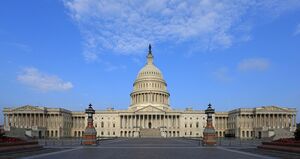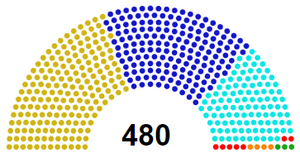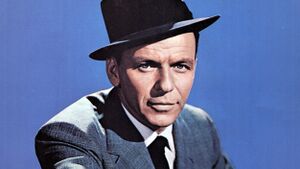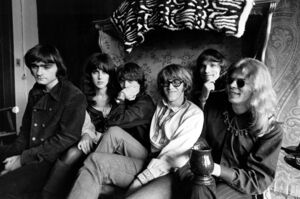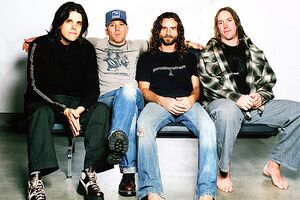Federal Union of Arcadia: Difference between revisions
MyNameIsChaz (talk | contribs) |
MyNameIsChaz (talk | contribs) |
||
| Line 246: | Line 246: | ||
|{{right|tbd}} | |{{right|tbd}} | ||
|- | |- | ||
!scope="row"|{{flagicon image| | !scope="row"|{{flagicon image|Hmmmmmmmm4.png|border=}} [[Clearwater Coast Commonwealth]] | ||
|CCC | |CCC | ||
|Commonwealth | |Commonwealth | ||
Revision as of 06:02, 23 December 2022
Federal Union of Arcadia | |
|---|---|
|
Flag | |
| Motto: He has sounded forth the trumpet that shall never call retreat | |
| Anthem: Mine Eyes Have Seen the Glory! official | |
| Capital | Providence |
| Largest city | Salem |
| Official languages | Arcadian Estarian |
| Recognised national languages | Mahican, Kanienʼkéha, Siouan, Niimi'ipuutímt, Numic |
| Ethnic groups (2020) | White(67.4%) Native Arcadians(22.6%) Other(10%) |
| Religion | Beaconerism |
| Demonym(s) | official Arcadian |
| Government | Federal presidential constitutional republic |
| President Mitchell J. Cole | |
| Vice President Tony W. Red Horse | |
| Legislature | Senate |
| Establishment | |
• Estarian Arcadian Colonies | 1603 |
• Arcadian Free States | 1795 |
• Confederacy of Arcadia | 1799 |
• Federal Union of Arcadia | 1809 |
• Water (%) | 2% |
| Population | |
• 2020 census | 305,150,700 |
| GDP (PPP) | 2021 estimate |
• Total | $14,577,048,939,000 |
• Per capita | $47,770 |
| GDP (nominal) | 2021 estimate |
• Total | $14,577,048,939,000 |
• Per capita | $47,770 |
| Gini (2021) | 34.5 medium |
| HDI (2021) | 0.932 very high |
| Currency | Federal Dollar (FUD) |
| Date format | mm/dd/yyyy (AD) |
| Driving side | right |
| Calling code | +777 |
| ISO 3166 code | FUA |
| Internet TLD | .arc |
The Federal Union of Arcadia (FUA, F.U.A.) commonly known as Arcadia, the Union, or the Federal Union is a country located in !North America. It consists of 11 Commonwealths, 2 Semi-Autonomous Republics, and numerous Federal Territories. The Union spreads across TBD square kilometers and comprises 305 million citizens, making it one of the largest in the world by size and population. While its largest city is Salem, the capital of the Union is Providence.
Evidence of Native Arcadian settlement within the FUA dates back to almost 18,000 years ago, while colonization began in the 15th and 16th centuries. The current Federal Union originated as the colonies of Estaria in the New World before they fought a short independence war in the early 1790s. By 1795 the Arcadian Free States had formed a loose alliance that rapidly broke down. In 1799 the Confederacy of Arcadia was formed by the Free State of Alexandria, the Republic of Western Freemen, and the Mahican Tribe. Two years later in 1801, the White Crow Mahican Band and Free State of New Jordan joined the Confederacy. 1807 saw the Federal War erupt between the Confederacy and the remaining three Free States (Salem, Rochester, and New Estaria) followed by their annexation.
In 1809, the first Confederate Congress met and agreed upon the Federal Constitution, thereby establishing the Federal Union of Arcadia and its first two subjects, the Free State Commonwealth and the New Estarian Commonwealth. Throughout the early and mid 19th century, the Union expanded across the continent through land purchases, diplomatic maneuvering, and rare military actions with failing colonial powers and Native Arcadian tribes and nations. The most recently admitted territory was the Siouan Republic in 1866, joining shortly after the Numic Republic.
Starting in the late 19th century, Arcadia was no longer seen as a backwater but as a modern economic powerhouse; fueled by mass immigration and plentiful natural resources, Arcadia had surpassed most Old World economies by 1900. With a surplus of economic power and diplomatic weight, the Union established its place at the international table and built a sphere of influence in its continental neighborhood. While neutral, the horrors of the !Great War convinced a generation of Arcadians that a neutral isolation in their hemisphere would be preferable to violent engagement with the Old World. Armed neutrality became the state policy for decades afterwards.
It wasn't until the end of the !Second Great War that public opinion began to shift. The declining power of Beaconerism over the electorate shifted pacifism and neutrality farther and farther out of the spotlight. In the 1950s the policy of Pax Arcadia became the driving foreign policy strategy of the nation- an attempt to build an international order centered on free trade, human rights, liberal democracy, and the containment of communism and fascism.
The Federal Union is a representative democracy and federal republic and the headquarters of numerous international organizations, most founded in and by the Union. Arcadia ranks very highly in development, economic freedom, human rights, education, healthcare, and social equality but has stagnated in economic equality.
From its founding, Arcadia has had a significant Beaconer religious majority, especially the Grand Lodge of the Brotherly Beaconers. This led to a rather uniform and conservative religious-political establishment for 150 years before the decline in Beaconer religiosity and influx of non-Beaconer immigrants resulted in the modern political landscape.
Etymology
History
Pre-colonization era
Colonization by Erisians
Early growth and independence movements
The Arcadian Revolution
The Continental Dash
Cattle Wars and Gunfighters
By nature of the rapid advance of Arcadian settlers across the West, the Federal government had a very difficult time keeping the peace and enforcing law and order in the highly decentralized Territories. Being subject to Federal and Territorial law meant very little to the wealthy landowners and cattle barons that had managed to acquire enough power and wealth, and corruption was rampant. Small town governments and local law enforcement officers were almost invariably in the pocket of their local cattle magnate, and this led to frequent clashes between popular interests and those of the powerful.
Equally as common as the clashes between poorer citizens and barons were the clashes between barons themselves. Cattle Wars broke out frequently, resulting in everything from hostile takeovers to massacres. Conflicts like the 1867 Morganstown Massacre led to the decades-long merge of the cowboy and gunfighter professions as barons made great efforts to hire cowboys that could not only effectively manage cattle, but also shoot with the best of them. Famous gunslingers produced by the era include William "Willy Wild" Jacobs, Creedence "John" Van Cleef, Felicity Strange, and Ezra Adlai "Easy Elt" Eltringham, all of whom died in gunfights.
It wasn't until the 1880s that the Union was able to muster the political power necessary to send Federal troops west to pacify the region through a campaign of land repossession, mass arrests of barons, and violent confrontation with the unorganized baron militias. A great deal of assistance was render by the Army Native Auxiliaries who provided scouting services and "extrajudicial" assistance to local unit commanders who faced greater scrutiny over the legality of their actions.
Arcadian Adventurism
Mass immigration and industrialization
Prosperous isolation
"Pax Arcadia" and Cold War
Millennium Crash to today
Government and Politics
Government
The Federal Union of Arcadia is a representative democracy comprising 11 Commonwealths, 2 Semi-Autonomous Republics, as well as a number of Federal Territories. As a federal presidential constitutional republic, Arcadia maintains a democratically-elected executive and legislative branch, as well as a judicial branch serving by a mix of local election and temporary appointment in Federal courts. The system of government used by Arcadia was designed in part by the victors of the Arcadian Revolution as a means of uniting the various colonial states and tribal bands, firstly into the Confederacy, and finally into the Federal Union. While the current Federal Constitution was originally written in 1808 and 1809, 33 revisions have been made since, each voted upon by the Senate and approved by the President and Supreme Court.
The Legislative Branch of the Federal Government is comprised of the 480-member Federal Senate, the unicameral legislature of the Union. As the legislature, the Senate has the ability to write legislation, approve Presidential requests to declare war (as well as to declare war itself), impeach any federal office, and budget the government's funds. There are 480 sitting Senators, each representing a Senatorial District and serving 3 year terms with a 4-term limit.
The Executive Branch is lead by the President, who is the Arcadian Head of State and Head of Government. The Presidents democratically elected every 4 years and may serve up to 3 terms in peacetime, or 4 in wartime. Powers of the President include the power of the veto, the role of the Commander-in-Chief of the Arcadian Federal Armed Forces, the selection of his cabinet, and the appointment of judges.
The Judicial Branch includes all Federal Courts, including the Supreme Court. Federal judges are appointed by the President and approved by the Senate and typically serve 10 year terms, though these can be and frequently are extended indefinitely.
At the moment, the Union can best be described as a three-party system, though a handful of smaller parties occasionally win minor representation in the Senate. Of the three major parties, the Liberal Party is typically described as center to center-right. The Progressive Party is a center-left party, sitting opposite the New Union Party, a generally right or center-right populist party. Of the represented parties in the Senate, the only others are the Socialist Party (left), Libertarian Party (right/far-right), and Green Party (left). Staggered elections ensure that there is an election every year in Arcadia, with three years of Senate elections, followed by a Presidential election; Presidential and Senate elections never overlap.
Elections, since 1950, have run on a ranked-choice, direct vote system. This includes both the Federal, Commonwealth/Republic, Territory, and Local government levels.
Political Divisions
As a federation, Arcadia sub-divides into 11 Commonwealths, 2 Semi-Autonomous Republics, and Federal Territories.
Commonwealths are not sovereign entities and act more as administrative divisions than political ones, though there may be differences between them as far as minor local law and regulation goes. Commonwealth governments are structured similarly to the Federal government, with an Executive, Legislative, and Judicial branch, though the judiciary of the Commonwealths is purely for criminal and civil purposes. At the head of a Commonwealth Executive is the Governor, directly elected and typically serving 4-8 year terms depending on the Commonwealth. While the OFLE handles major violations of federal law, Commonwealths all operate their own law enforcement agencies.
The Semi-Autonomous Republics are semi-sovereign states and have a theoretically larger degree of latitude in making legislation and local law, as well as to raise non-Federal Gendarmes. While these states function very similarly to Commonwealths per federal law, a number of differences owing to the cultural traditions of the constituent tribes are apparent. In the case of the Siouan Republic, a Chief of the Republic is chosen by the Tribal Councils of the Siouan Tribal Confederation; the Chief of the Republic (and Republic itself) is fully subject to Arcadian federal law, but is given the respect and ceremony of a foreign leader when meeting with the President. In the Numic Republic, no central Chief is chosen, but a Council of Chiefs (usually 4) is elected by the Great Council to act as its Executive. Both Republics operate small gendarmes made up traditionally of tribal veterans of the Arcadian military, which all Republic citizens are legally allowed to enlist in. These gendarmes cannot be federalized, even during war, though the Republics can volunteer them to federal service.
Federal Territories are regions of Arcadia that are not administered by Commonwealths or the Republics. This includes military bases, federal parks, the city of Providence, and any overseas territory, including that occupied by the Federal Armed Forces. Maintenance of these territories is funded exclusively by the Federal Government, and law enforcement duties fall to the OFLE, Federal Armed Forces Military Police, or Federal Park Rangers. Commonwealth taxes cannot be levied against permanent residents of Federal Territories, but federal taxes are.
| Flag and name with federal abbreviation and status | Cities | Population | |||
|---|---|---|---|---|---|
| Capital | Largest | ||||
| FSC | Commonwealth | Innsmouth | Salem | tbd | |
| GTR | Commonwealth | Kerhitekanónhsa | Kensington | tbd | |
| NEC | Commonwealth | New Wickham | Spinnaker | tbd | |
| ADC | Commonwealth | Mississinewa | tbd | ||
| GTR | Commonwealth | Fort Drake | tbd | ||
| PDC | Commonwealth | Homme | Warren | tbd | |
| CAC | Commonwealth | Cornell City | tbd | ||
| CCC | Commonwealth | Clearwater | tbd | ||
| CLD | Commonwealth | Meridian | tbd | ||
| WIN | Commonwealth | Lucky Peak | Carsonville | tbd | |
| WAB | Commonwealth | Kokomo | Manning | tbd | |
| SIR | Semi-Autonomous Republic | Oglala | tbd | ||
| NUR | Semi-Autonomous Republic | Kotsoteka | Snake River City | tbd | |
Foreign relations
Military
Law Enforcement
Intelligence Community
Geography
Location
Flora and fauna
Science
Science in Arcadia
Space Program
Economy
Energy
Demographics
Ethnic groups
Religion
Health
Culture
Cuisine
Architecture
Cinema
Media
Literature
Sport
Sports in Arcadia make up some of the most popular pastimes; in particular Arcadian Football, Basketball, Baseball, and K-Mo Formula Racing attract the greatest amount of TV viewership and in-person attendance. Additionally, golf, hockey, soccer, and numerous other sports have sizable presences in the Union. Governing bodies include the PFA for football, NBO for basketball, ABL for baseball, and K-Mo Racing for K-Mo formula racing.
Major sporting events, such as the Arcadian Professional Football yearly championship known as the Union Bowl, as well as baseball's Grand Old Arcadian Baseball Series earn tens of millions of international viewers every year. While the Union Bowl is the most-watched Arcadian sporting event with domestic audiences, it's the K-Mo Classic 500 race held in the Kokomo SuperSpeedway in Kokomo, Wabash Commonwealth, that attracts the most total viewers via international broadcast. K-Mo racing attracts a great deal of foreign interest on account of a great degree of international participation, an example being the highly successful teams Forza Automotive and Delta-V Racing from Septi and Picisola.
Other popular events include the NBO's finals, known as the Continental Series, as well as the various college-level athletic events hosted throughout the year.
Overall, the sports industry and market in the Union is worth an estimated $61 billion yearly, the highest in the world.
Music
Some of the earliest music popular in Arcadia were church hymns brought over from Erisia by immigrants and colonists; many of these hymns would go on to form the basis of different kinds of folk music across Arcadia. After independence, several composers made names for themselves in Arcadia, such as Vincent Howerdell, Gregory Ryan Clinton, and Clayton Gaines. Salem and Providence would remain pillars of musical culture well in to the 20th century.
Salem saw a renaissance of musical plays and showtunes in the early 20th century, sometimes to the chagrin of the conservative Beaconer establishment that harbored distaste for perceived hedonism and anarchism espoused by these shows. Despite religious intolerance, Salem's famous College Street became a world-renowned center for plays and musicals.
From the 1930s onwards, jazz, swing, and big band music became pop staples for an eager Arcadian market. Arcadian artists like Donnie Solano, Ernie Davis Brown, Babe McCallister, Avaline Wynn, and Chuck De Niro became household names and went on to wildly successful musical careers all throughout the 40s, 50s, and 60s.
Starting in the 1950s, Libertine rock 'n roll musicians began to explode in popularity across both the Libertines and Arcadia. Richie Goode, a Libertine rock and roller, is seen by most as kicking off this revolution in music with his number one hit, Roll Over Hoevermann. Shortly afterwards, Arcadians began to take part, and soon enough the Arcadian rock genre had come to utterly dominate charts across the nation. Jesse Vernon was one of the first Arcadian artists to embrace the rock sound, charging up the charts with energetic performances and provocateur. Vernon eventually came to be known as the King of Rock and Roll.
Throughout the next two decades, rock and roll's various subgenres remained the most popular music across radio stations and charts alike, mostly led by Arcadian acts and bands like The Dailies, Billy van Dink, Bobby Hill, The Clearwater Preachers, and Funny Things. Libertine genres such as funk, R&B, and soul music also crossed over to Arcadian audiences, even influencing mainstream rock bands and creating subgenres like funk rock. In more conservative religious circles, Libertine and Arcadian gospel music remained in high demand.
Both metal and punk music entered the scene in the 1970s, but their heyday was the 1980s when many of the big rockers of the 60s and 70s began to drop off. Social liberalization and youth rebelliousness fed into the anti-establishment themes frequented by punk and metal, causing frequent culture clashes between the Beaconer establishment and younger generations. Metal acts like The Militia, Snakeshot, Shock and Awe, and the highly controversial Hellpriests sold millions of albums, while punk bands such as Fuck, Weaselmen, Dirt Poor, Kaiser Ford, and The Strike consistently moved nearly as many records as their metal challengers. This decade also saw a great deal of competition between metal and punk fans, sometimes degenerating into lawlessness and gang violence, which fed into Beaconer establishment narratives that music was feeding violence and social breakdown. Regardless, a number of attempts at censorship by right-wing NUP Senators were shot down between 1978 and 1991.
In the late 1980s and into the 90s, numerous shifts occurred in Arcadia music with the birth of grunge rock and the emergence of numerous metal subgenres, the mainstream appearance of rap and hip-hop from the Libertines, and the loosening of social taboos. An economic downturn in the early 1990s and increased openness and drug use in young adults and teenagers coincided with the meteoric rise of grunge artists like Spoonmen, Undertow, Black Days, The Opium Vanguard, and Window. Nearing the end of the 90s, several rock subgenres experienced greater success as grunge began to fade. Prog metal bands like Rosetta and Morpheus Haze headlined numerous cross-country festivals that attracted hundreds of thousands of attendees, while nu-metal rockers including Psych and Vitriol catered to an angsty youth bored of the grunge era.

